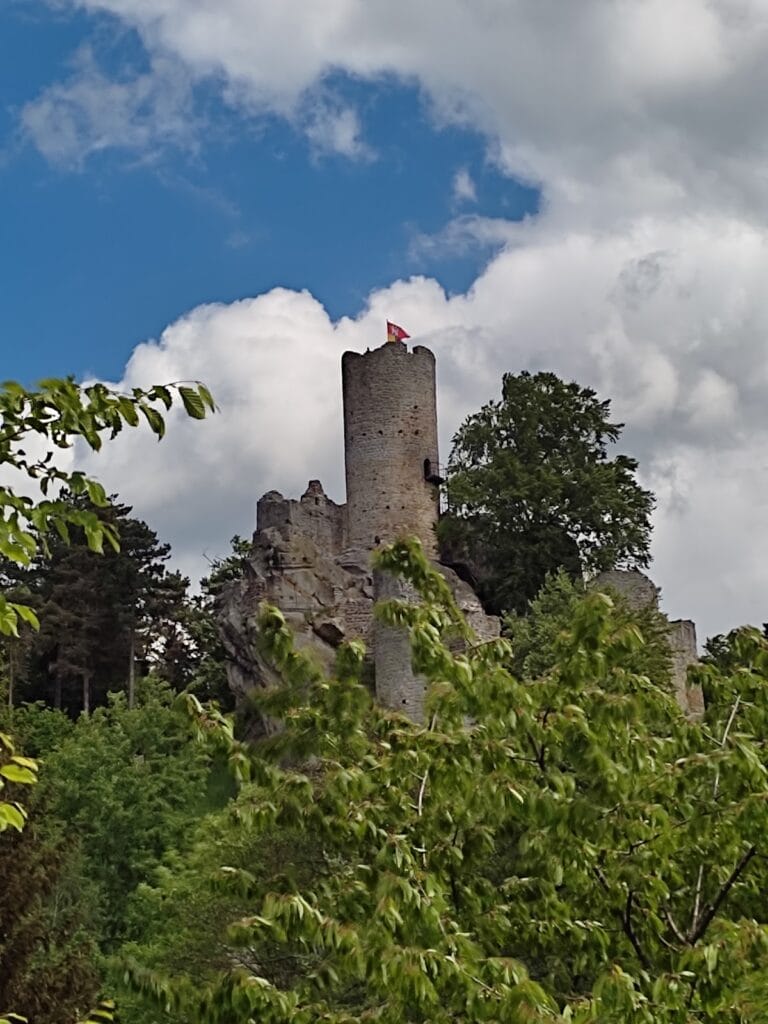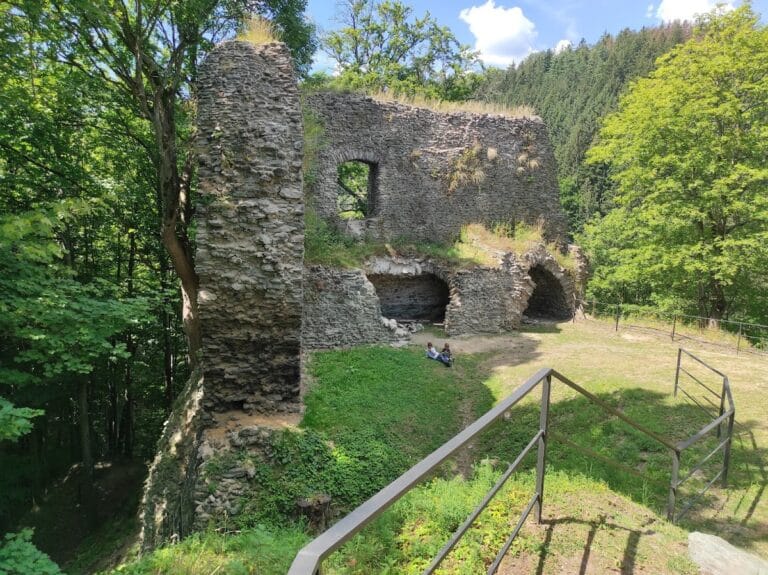Frýdlant Castle: A Historic Medieval and Renaissance Fortress in the Czech Republic
Visitor Information
Google Rating: 4.7
Popularity: Medium
Google Maps: View on Google Maps
Official Website: www.zamek-frydlant.cz
Country: Czechia
Civilization: Medieval European
Remains: Military
History
Frýdlant Castle is situated in the town of Frýdlant, within the modern Czech Republic, and was built by medieval Bohemian nobility. Its origins reach back to the first half of the 13th century, although local tradition suggests that a large tower known as Indica stood on the site as early as 1014. The castle occupies a strategic position atop a basalt rock peninsula overlooking the Smědá River, part of important medieval trade routes linking the area with nearby towns like Zittau and Görlitz.
The earliest documented name of the settlement, Frýdlant, appears in records from 1257, while the fortress itself was probably established around 1241. This timing coincides with the need to protect the region from the threat of Mongol invasions, reflecting its role as a defensive stronghold. Initially, the estate belonged to the Ronovci noble family until 1278, when King Přemysl Otakar II seized it and transferred ownership to the knight Rudolf von Biberstein. The Biberstein family would maintain control for nearly three centuries, during which period they expanded and modernized the fortifications and promoted the growth of the nearby town.
Throughout the 13th and 14th centuries, Frýdlant developed not only as a military bastion but also as an administrative center. The town itself was fortified and granted various privileges, including the establishment of a school. The castle and town faced significant challenges during the Hussite Wars in the 15th century, with the town suffering devastating fires in 1427, 1428, 1430, and 1432. Despite these assaults, the castle remained unconquered, underscoring its robust defenses.
In 1493, the Biberstein family divided into two branches, with the line controlling Frýdlant ending in 1551. Subsequently, the estate was declared a “dead fief,” a term indicating it had no immediate heir in the royal domain. In 1558, Bedřich von Redern acquired the castle and undertook an extensive Renaissance-style reconstruction. This work, guided by Italian architect Marco Antonio de Lanzio, introduced a new residential palace known as the “Upper Castle” and constructed a chapel dedicated to St. Anne between 1598 and 1602. The chapel’s interiors were adorned by prominent artists such as Ambrosius Fritsch and Bartholomeus Spranger, reflecting the period’s artistic trends.
The Redern family’s ownership ended in 1622 when their involvement in the Bohemian Revolt led to confiscation of their properties. The castle was then sold to Albrecht von Wallenstein, a leading military figure in the Thirty Years’ War. Wallenstein reinforced the fortress but left its overall structure mostly intact. Under his stewardship from 1621 to 1634, the region enjoyed relative peace and prosperity, earning the nickname “Terra felix,” Latin for “Happy Land.”
After Wallenstein’s assassination in 1634, the castle passed to General Matthias Gallas. During his tenure, the stronghold saw multiple occupations by Saxon and Swedish troops amid the ongoing Thirty Years’ War. The Swedish forces enhanced the castle’s fortifications with additions such as a large barbican and distinctive pentagonal bastions known as “Sharp Angles.” Despite these wartime pressures, the estate remained an important military and administrative site.
By the late 17th century, the Gallas family encountered financial difficulties and faced peasant uprisings, including a notable rebellion led by blacksmith Andreas Stelzig between 1679 and 1687. Stelzig was subsequently imprisoned within the castle. Ownership continued under the Gallas family and later the Clam-Gallas lineage into the 18th century, who were notable patrons of arts and diplomacy. Among them, Johann Wenzel von Gallas and Christian Philip Clam-Gallas supported cultural figures such as Ludwig van Beethoven.
Frýdlant Castle opened its doors as a museum in 1801, becoming the first castle museum in Central Europe. Exhibitions housed collections ranging from furniture and paintings to thousands of hunting and military weapons, as well as an exceptional assortment of pipes. The Clam-Gallas family held the castle until 1945, when it was nationalized by the Czechoslovak government. Subsequent restorations and conservation efforts throughout the 20th and 21st centuries, including major renovations begun in 1995, have preserved and enhanced the site’s historic character. At one point, speculation arose from two German researchers that the legendary Amber Room might be concealed in a secret chamber within the castle, though investigations yielded no evidence.
Remains
Frýdlant Castle occupies a commanding position atop a basalt rock peninsula overlooking the Smědá River, combining a medieval fortress with later Renaissance residential structures. The core medieval complex features a massive circular stone tower, known as a bergfried, notable for its thick walls measuring up to four meters at the base. This tower was connected on its northwest side to a fortified residential palace, forming the stronghold’s earliest defensive and living quarters.
Throughout the 14th and 15th centuries, the castle’s defenses were expanded to include bastions and two gate towers: a southern gate tower and a northern gate tower accessed via a bridge. In the 16th century, these fortifications were further extended outward to protect the outer bailey—the courtyard area outside the main walls—and to support the use of artillery, reflecting advancements in military technology of the period.
Between 1582 and 1602, the castle underwent a Renaissance transformation under the direction of Italian architect Marco Antonio de Lanzio. This phase replaced the older Gothic palace with the new “Upper Castle,” a residence distinguished by richly decorated interiors featuring stucco and sgraffito—a technique involving layers of plaster to create intricate designs on the facades. An octagonal stair tower was also added to this residence. Opposite its entrance, a chapel dedicated to St. Anne was constructed and connected to both castle sections by a covered corridor, providing direct access between the fortress and the chapel.
While these Renaissance changes softened some of the castle’s military character, emphasizing comfort and style instead, defensive works remained a priority in subsequent years. During the Thirty Years’ War, Swedish forces notably improved military defenses by building a substantial barbican—a fortified outpost located before the main gate—and erecting five-sided bastions called the “Sharp Angles.” They also modernized the castle’s moat. A Latin inscription carved by Swedish commander Benjamin Magnus Nortmann is preserved on a wall dating from this period, attesting to their presence and work.
The lower portion of the castle, called the “Lower Castle,” saw additions in the 19th century, including two-story wings and a castellated tower featuring embrasures (openings for firing weapons) and battlements atop a pentagonal bastion. This expansion enhanced the site’s symbolic military style while accommodating residential and administrative uses.
The castle is enclosed by a network of walls and multiple gates, and its grounds include a terraced park and agricultural buildings. The chapel stands out on the northern side of the complex. Inside, visitors find extensive collections of historic furnishings, paintings, and over a thousand hunting and military weapons. Porcelain, glassware, and an exceptional variety of smoking pipes form part of the eclectic assemblage. The interior also includes a knight’s hall and a family burial vault located in the nearby parish church. Restoration efforts have preserved original Renaissance sgraffito decorations on the facade, highlighting the castle’s artistic legacy.
Major renovation campaigns, notably in the late 19th century in a historicist style and again from 1995 onward, have focused on repairing roofs, reinstating interior decorations, and restoring collections to reflect their historic appearances. Today, Frýdlant Castle stands as a protected cultural monument of the Czech Republic, recognized for its layered history and architectural significance.










